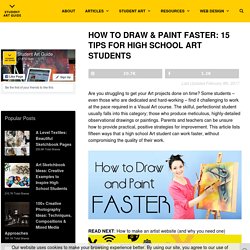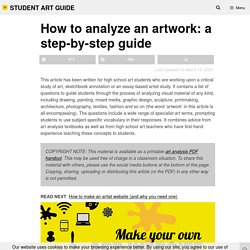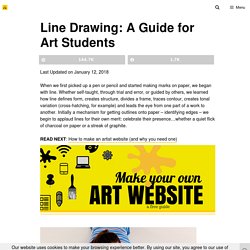

How to develop your ideas: A Level Art Coursework development. Last updated February 8th, 2017 Many high school Art students (such as those studying AS or A2 Level Art & Design) must present a Coursework or Exam portfolio that shows development.

Students are sometimes confused about what the term ‘development’ means in this context, and are uncertain about how they should go about achieving this. This article endeavours to answer these questions and provides a process by which students can ensure their work develops sufficiently. This is intended as a broad guide only, and should be used only in conjunction with advice from your teacher. If you are told that your work must show development, your teacher is telling you that your work must change a little (both in use of media and composition) from one piece to the next. As an example, the following process was undertaken by my A Level Painting students (this process could be easily modified for Graphic Design, Photography or Sculpture) during the course of the year: 1. 2. 3. 4. 5. 6. Still unsure? Samantha Li - GCSE Art Exam: Force. Last updated February 8th, 2017 This Edexcel GCSE Art exam was completed by Samantha Li, while studying at West Island School, Pokfulam, Hong Kong.

Samantha was awarded full marks for her examination, gaining 100% (A*) overall. She explored a fantasy / spiritualistic theme, interpreting the set starting point ‘Force’. Many students panic when their Art exam paper arrives. They worry that they won’t be able to come up with a creative interpretation and sometimes spend weeks fretting over their ideas (in fact, students are doing this now, in our forum). We were lucky enough to interview Samantha about her project. What was your GCSE Art exam topic and how did you interpret this? Samantha: The exam topic was ‘Force’ and the first thing I thought of was to do with Star Wars, but that was irrelevant!
In the end, I went with the concept of ‘anti-force/upside down force’. The first painting (the vertical image at the end of this article) has a fantasy/spiritual theme. How to draw & paint faster: 15 tips for high school Art students. Last updated February 8th, 2017 Are you struggling to get your Art projects done on time?

Some students – even those who are dedicated and hard-working – find it challenging to work at the pace required in a Visual Art course. The skilful, perfectionist student usually falls into this category; those who produce meticulous, highly-detailed observational drawings or paintings. Parents and teachers can be unsure how to provide practical, positive strategies for improvement.
This article lists fifteen ways that a high school Art student can work faster, without compromising the quality of their work. 1. There are many benefits to working on a ground. How to Avoid the Cliché in a High School Art Project. Last updated February 8th, 2017 Starting a new unit of work or responding to an exam question can be a daunting prospect for even the most confident of high school Art students.

It is often difficult to ensure your work is totally original, especially if you have picked a theme that may already have been responded to lots of times before. It should be an exciting challenge to try and make work that is innovative and individual, but sometimes avoiding cliché can be difficult. When your work is assessed, there isn’t a box to tick that says you need to avoid the cliché in order to be successful. However, arts-based students should be aware that markers, assessors and university/college interviewers are likely to have seen countless portfolios containing similarly themed work. Art Sketchbook Ideas: Creative Examples to Inspire High School Students. This article provides tips and guidance to help you produce an outstanding high school sketchbook.
International GCSE Art Sketchbook Examples. Last updated February 8th, 2017 The A3 sketchbook examples shown in this blog post were created by my sister Heather Garland (aged seventeen) and I, prior to my first year of teaching IGCSE Art and Design (the International equivalent of GCSE Art, assessed by Cambridge University).

I employed Heather to work for me during the Christmas holidays: together we created sketchbook pages that could be used to inspire and guide my students. In 2002, the internet was not the wealth of resources it is today: I needed physical Painting and Related Media Coursework examples that my students could learn from. The sketchbook pages you see here are based a ‘Coastal Environment’ theme: the exploration of natural forms, such as shells, plants and seascapes.
Sketchbook Development. Stunning A Level Art Sketchbook, Preparation and Final Piece. Last updated February 8th, 2017 These last few weeks I have been fortunate enough to write about three amazing A Level Art portfolios.

This is the second of the three: a comprehensive and well-executed A2 Painting project (AQA A Level Fine Art) awarded 100%. How to analyze an artwork: a step-by-step guide. Last Updated on November 30, 2018 This article has been written for high school art students who are working upon a critical study of art, sketchbook annotation or an essay-based artist study.

Line Drawing: A Guide for Art Students. Last Updated on January 12, 2018 When we first picked up a pen or pencil and started making marks on paper, we began with line.

Whether self-taught, through trial and error, or guided by others, we learned how line defines form, creates structure, divides a frame, traces contour, creates tonal variation (cross-hatching, for example) and leads the eye from one part of a work to another. Initially a mechanism for getting outlines onto paper – identifying edges – we begin to applaud lines for their own merit: celebrate their presence…whether a quiet flick of charcoal on paper or a streak of graphite. This article contains exercises for Art students who wish to produce contour line drawings, cross contour drawings, blind drawings and other types of line drawings. It is a teaching aid for high school Art students and includes classroom activities, a free downloadable PDF worksheet and inspirational artist drawings. Blind Contour Drawing Gesture Drawing / Timed Drawing / Movement Drawing.